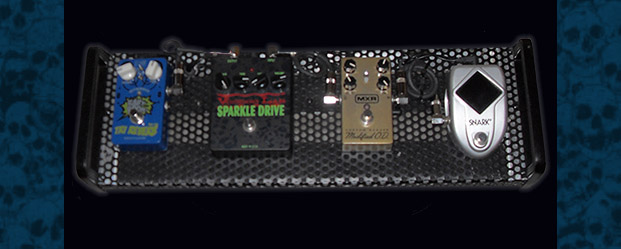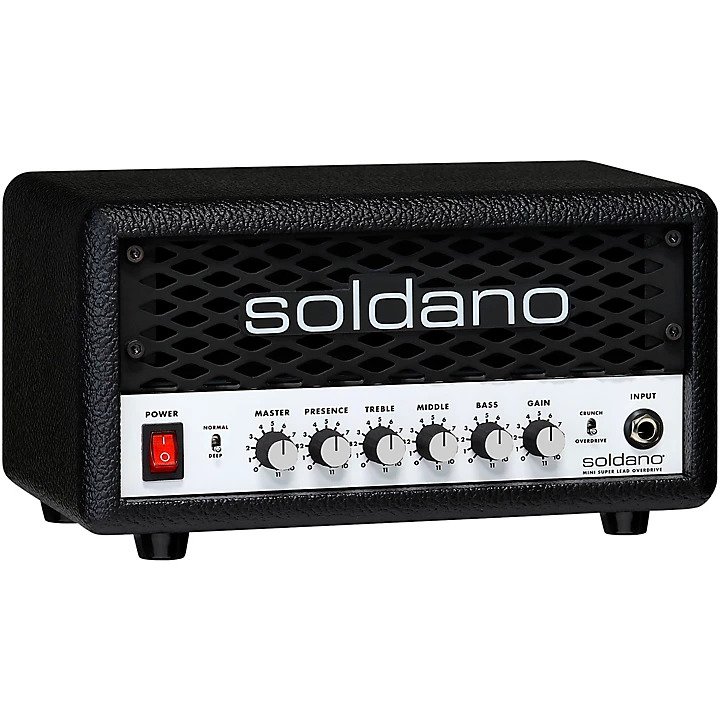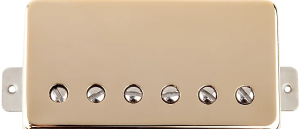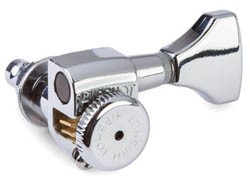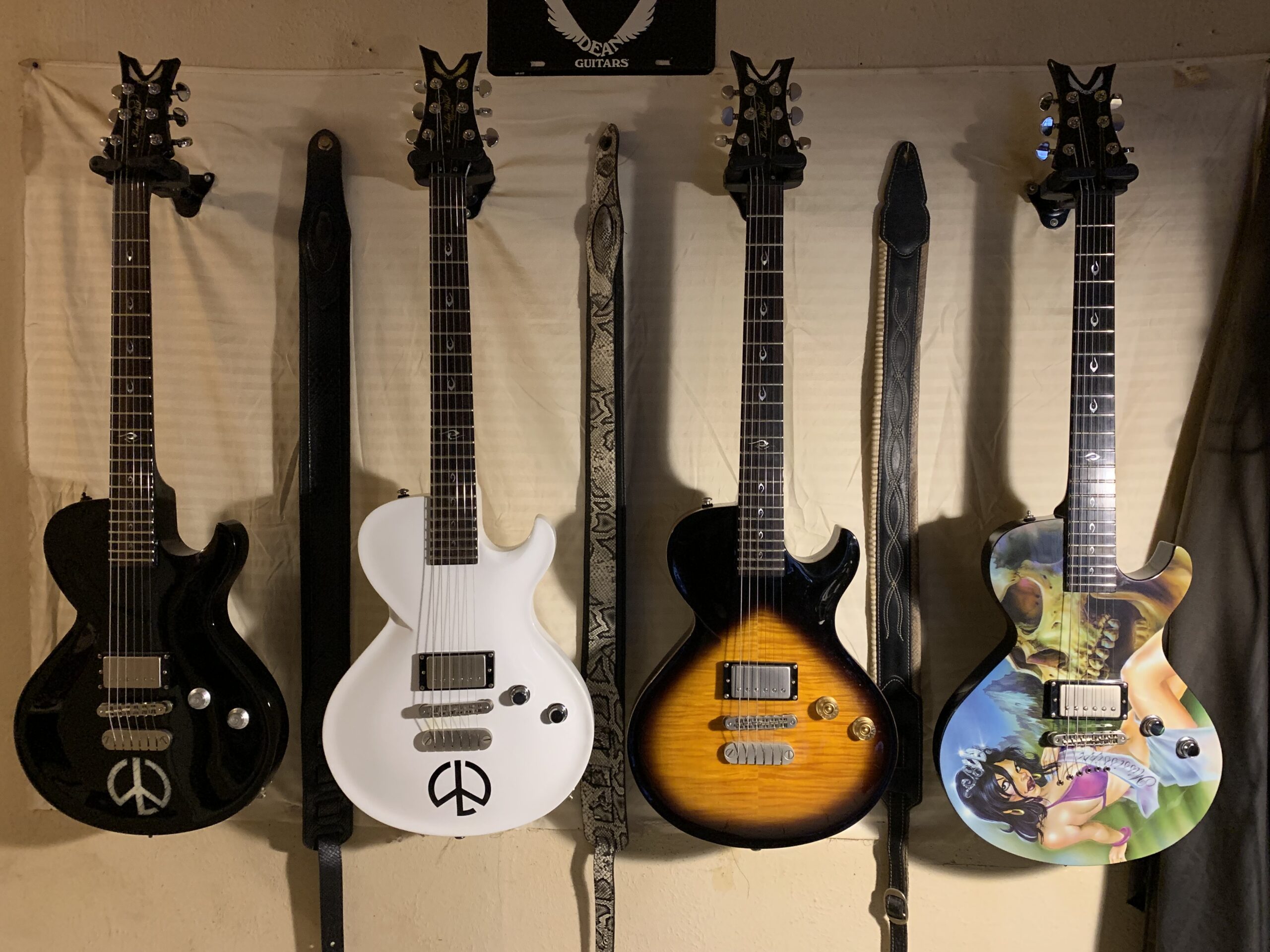
Stomp Box DIY For Beginners
So you want to build your own guitar FX pedals eh?
 If you’ve tried getting into the whole DIY thing you know how frustrating it can be for a newbie to figure how to do certain things especially if you want to build fx pedals (trust me I know). There’s tons of sites that are excellent resources for this and these guys know what the hell they’re talking about, and the forums and/or comments are packed full of information. But they are generally geared for those with knowledge of electronics and even experience doing their own mods. I started out with less then a cursory knowledge of electronics but I have now taught myself how to mod my own tube amps, mod pedals, and even build pedals from scratch. If I can do it so can you. Pick a starting project then research research research. And when you done researching it do it some more. I can’t stress this enough. The info is there, you just have to find it. What I’m putting out in this article is a method for beginners that will help with some of the more common issues faced when learning to do this shit. Here’s how it works: the usual starting point for any project is a schematic. As far as schematics go, far and away the best method to use is a vero board layout. These are much more than a schematic as far as I’m concerned. They’re readily available on the net and they really make placement of the components easier, but it has its quirks too. Like soldering all those tiny connections without creating tiny little solder bridges. Bottom line is it simply takes practice and experience. This variation will make it easier to get that experience. Keep in mind that this is in no way meant as a permanent method of using vero board, rather it’s a way to complete a few builds successfully, gain a bit of experience at soldering and start learning about circuits all at at the same time without much of the frustration and a box full of failed projects (I know all about that too).
If you’ve tried getting into the whole DIY thing you know how frustrating it can be for a newbie to figure how to do certain things especially if you want to build fx pedals (trust me I know). There’s tons of sites that are excellent resources for this and these guys know what the hell they’re talking about, and the forums and/or comments are packed full of information. But they are generally geared for those with knowledge of electronics and even experience doing their own mods. I started out with less then a cursory knowledge of electronics but I have now taught myself how to mod my own tube amps, mod pedals, and even build pedals from scratch. If I can do it so can you. Pick a starting project then research research research. And when you done researching it do it some more. I can’t stress this enough. The info is there, you just have to find it. What I’m putting out in this article is a method for beginners that will help with some of the more common issues faced when learning to do this shit. Here’s how it works: the usual starting point for any project is a schematic. As far as schematics go, far and away the best method to use is a vero board layout. These are much more than a schematic as far as I’m concerned. They’re readily available on the net and they really make placement of the components easier, but it has its quirks too. Like soldering all those tiny connections without creating tiny little solder bridges. Bottom line is it simply takes practice and experience. This variation will make it easier to get that experience. Keep in mind that this is in no way meant as a permanent method of using vero board, rather it’s a way to complete a few builds successfully, gain a bit of experience at soldering and start learning about circuits all at at the same time without much of the frustration and a box full of failed projects (I know all about that too).
(side note: You have to keep in mind that you are going to have failures. No way around that. Bugs are a fact of life for even the most experienced stomp box builder, and learning to diagnose bugs is part of the process. And you will use Google a lot. Research goes a long way remember? But this will help reduce at least some of the more common mistakes when you’re just starting out)
It’s simple really, You take a vero layout and expand it out to put an unused row and column between each valid row and column. Fig. 1 shows a component that’s actually in the exact same location on each board. It’s just that the second board is expanded. On my first attempt I kept losing track of the unused rows so I marked them out with a black Sharpie marker like Fig. 2.
The down side is you have to use the larger enclosure due to the larger board, but this is only meant to allow you to create a few successful builds and fine tune your soldering hand before you go for the smaller boards. Then you can start using the smaller enclosures. Another thing you will run into is mounting transistors and IC chips. For transistors the solution is simple: use sockets. In Fig.3 you can see how to bend the pins to make it work. If you need a 3 pin socket just make it a 5 and clip the pins off the ones not used. IC chips (op-amps etc) are another issue and I have a workaround for that as well. Here’s a link to it. IC_Chips .
As far as vero board goes there are two types (that I know of). One uses copper strips and the other uses silver (Fig. 4). I prefer the silver strips and I solder them with silver solder. There is no real technical reason for that it’s just that I like the boards with the silver strips and it just seemed logical to use silver solder. It seems to hold up quite well as it withstands the heat from the solder better than copper.
The solder I use is .022″ Dia. rosin core Silver Solder 62/36/2 because it has a slightly lower melting point than 60/40 and it snaps back fast. Just make sure you don’t move the component till the solder flashes or you could end up with a poor solder joint.
Fig.5 shows an expanded board in an enclosure. Fig. 6 is the front. This is an EQD Crimson Drive and it sounds incredible. And, yes, I had some bugs with it but it was just one missed cut on the second strip from the top. And it only took me a day and a half to figure it out. It’s the simple ones that really get you. But all is right with the world now. I also did an EQD Speaker Cranker that turned out great as well, but both will be redone with a standard vero board and placed into a small enclosure in the next few weeks. Then I can always reuse the larger enclosures for a build that requires it. No waste.
One last suggestion, when you’re looking for a layout for your first several builds, don’t pick one that has a gazillion components on the board. Pick one with as few comps as possible. If you want to find out what a particular design sounds like just youtube it, but keep in mind that your build won’t sound exactly like the demo. Hell they don’t sound the same even when you go buy a new pedal. But the videos can give you a general idea so at least you will know what territory you’re in.
So there is my contribution the the DIY world. If this helps even one person to get started then it was all worth it. Here are some links that you will find useful and indispensable. They contain the knowledge of the DIY universe. The first one on the list is a video channel with a bunch of great videos for everybody from beginners on up to seasoned builders.
https://www.youtube.com/user/chromespherecom
https://tagboardeffects.blogspot.com/
https://www.freestompboxes.org/
https://buildyourownclone.com/
https://www.generalguitargadgets.com/
Related articles
- Re: Soldering Stations Expensive but Handles are Cheap! (eevblog.com)

Blackberry Smoke New Release
 The new Blackberry Smoke album titled “Holding All the Roses” is out. They’ve been releasing a few songs on line in advance of the full release and they generated a lot of interest because sound better than ever. You can check out one of the videos below. It’s ailable on CD and they also have a limited edition vinyl album that’s pretty cool if you’re into vinyl https://www.blackberrysmoke.com/shop.html There’s also a couple of tunes off the album on their site as well. This is one hard rockin’ record for sure so be sure to check it out, you won’t be disappointed.
The new Blackberry Smoke album titled “Holding All the Roses” is out. They’ve been releasing a few songs on line in advance of the full release and they generated a lot of interest because sound better than ever. You can check out one of the videos below. It’s ailable on CD and they also have a limited edition vinyl album that’s pretty cool if you’re into vinyl https://www.blackberrysmoke.com/shop.html There’s also a couple of tunes off the album on their site as well. This is one hard rockin’ record for sure so be sure to check it out, you won’t be disappointed.
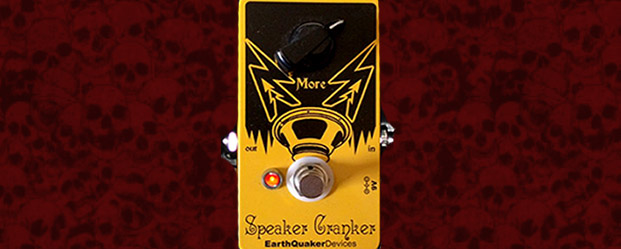
Speaker Cranker Overdrive
Earthquaker Devices Speaker Cranker
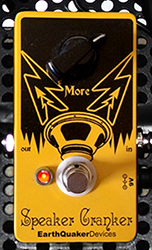 Ever since I got the Orange OR15 I haven’t used dirt pedals much. It really doesn’t need one unless you want to set the amp clean then drive it with a pedal so you can don’t have to fiddle with the amps controls to get the grit and grind when you need it. The problem was that even a low or medium gain overdrive seemed like it was just too much. So I started looking and rediscovered a great pedal: Earthquaker Devices Speaker Cranker. This is a one knob dirt pedal that sounds sweet at every setting. It’s a true bypass overdrive that can give you a mildly gritty boost or full-on overdrive. And just like all the other pedals that claim “transparency”, this one also colors your sound, but not very much. It rolls the highs off a bit which imho is a good thing, and it gives the tone a fuller, rounder sound. And it’s totally controllable. It has one control knob labeled “More” which controls the gain and makes the pedal super easy to use. The only issue I had was with the LED indicator. It’s bright white and when you turn it on the light blinds you. But this is a minor thing and was easily fixed with a dark red “Prismacolor” marker. The Orange really likes this one, and so do I. I’m just sorry I didn’t try one out a long time ago. I did think about it once, but never pursued one. Bottom line: it’s a keeper.
Ever since I got the Orange OR15 I haven’t used dirt pedals much. It really doesn’t need one unless you want to set the amp clean then drive it with a pedal so you can don’t have to fiddle with the amps controls to get the grit and grind when you need it. The problem was that even a low or medium gain overdrive seemed like it was just too much. So I started looking and rediscovered a great pedal: Earthquaker Devices Speaker Cranker. This is a one knob dirt pedal that sounds sweet at every setting. It’s a true bypass overdrive that can give you a mildly gritty boost or full-on overdrive. And just like all the other pedals that claim “transparency”, this one also colors your sound, but not very much. It rolls the highs off a bit which imho is a good thing, and it gives the tone a fuller, rounder sound. And it’s totally controllable. It has one control knob labeled “More” which controls the gain and makes the pedal super easy to use. The only issue I had was with the LED indicator. It’s bright white and when you turn it on the light blinds you. But this is a minor thing and was easily fixed with a dark red “Prismacolor” marker. The Orange really likes this one, and so do I. I’m just sorry I didn’t try one out a long time ago. I did think about it once, but never pursued one. Bottom line: it’s a keeper.
Related articles
- Evaluating an Overdrive Pedal (guitargear.org)
- Do We Have “Transparency” All Wrong? (guitargear.org)

The Pretty Reckless Going to Hell
The Pretty Reckless: Taylor Momsen (lead vocals, rhythm guitar), Ben Phillips (lead guitar, backing vocals), Mark Damon (bass) and Jamie Perkins (drums).
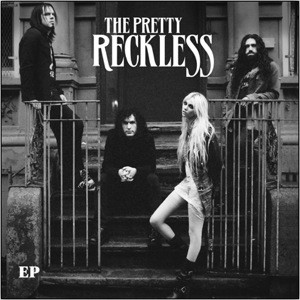 Here’s a band that I was actually aware of for some time but only recently listened to and I was completely blown away. The reason I didn’t pay attention before was because the singer is actress Taylor Momsen from the tv show Gossip Girl, and I just assumed (wrongly) that it was another band not to be taken to seriously. Which is usually the case when a teenaged actress starts singing and cutting tracks. Such is NOT the case with this band. I caught a video on you tube by accident (I was aiming for the video above it) and man, I’m just glad my aim was off that day. I have since learned that Taylor Momsen has always been into the music. She cut her teeth on the Beatles (her #1 favorite), the Who, AC/DC and so on. She views her acting as a day job and her music is what she does because she loves it. I believe she actually left the tv show due to an upcoming tour which backs up her day job statement. Not that she needed to back it up though. Watching them perform it’s obvious she’s serious about it. She’s one of the best rock singers I’ve ever heard, male or female. She’s a rock star to the bone like she was born to it. And on top of all that she co-wrote all the tunes on the new album “Going to Hell”.
Here’s a band that I was actually aware of for some time but only recently listened to and I was completely blown away. The reason I didn’t pay attention before was because the singer is actress Taylor Momsen from the tv show Gossip Girl, and I just assumed (wrongly) that it was another band not to be taken to seriously. Which is usually the case when a teenaged actress starts singing and cutting tracks. Such is NOT the case with this band. I caught a video on you tube by accident (I was aiming for the video above it) and man, I’m just glad my aim was off that day. I have since learned that Taylor Momsen has always been into the music. She cut her teeth on the Beatles (her #1 favorite), the Who, AC/DC and so on. She views her acting as a day job and her music is what she does because she loves it. I believe she actually left the tv show due to an upcoming tour which backs up her day job statement. Not that she needed to back it up though. Watching them perform it’s obvious she’s serious about it. She’s one of the best rock singers I’ve ever heard, male or female. She’s a rock star to the bone like she was born to it. And on top of all that she co-wrote all the tunes on the new album “Going to Hell”.
This is a seasoned hard rock outfit of solid musicians. Heavy riffs, solid backbone, explicit lyrics and everything that’s rock and roll!. It reminds me of when “rock and roll” was like flipping  off the establishment. With titles like “Make Me Wanna Die“, “Fucked Up World” and “Why’d You Bring A Shotgun To The Party” this crew is flipping them off with both hands.
off the establishment. With titles like “Make Me Wanna Die“, “Fucked Up World” and “Why’d You Bring A Shotgun To The Party” this crew is flipping them off with both hands.
One other thing, and I’ll only say this once, Taylor is smokin’ hot. That certainly doesn’t hurt anything at all but seriously that is NOT why I like this band. I mean really, I could have watched them a long time ago if I wanted to just look at her. It’s part of the appeal, no way around that, and I’m not complaining, believe me. But if the music wasn’t good they wouldn’t last very long in the choked out music market even with her looks. And the new album came out at #5 on iTunes and only talent can get you there. So here is there new video for you to check out. Oh yeah, don’t just turn the volume up. CRANK IT TO ’10’ AND TEAR OFF THE KNOB!

Orange OR15 Amp Full Review
FYI: there were originally 3 posts on the Orange, but I just put them all together in this one post to consolidate. So if you get the impression that I’m a nut-job, I’m not. Not so you would notice much anyway. It’s just how the 3 posts sound being written on different dates then thrown together.
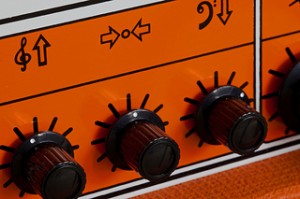 1. Big things happening around here. I just pulled the trigger on a new Orange OR15. I still love my Jet City, but there’s something about Orange that’s like nothing else. So when a deal presented itself I was all over it. After I’ve played it for about a week I’ll post an article with the lowdown on performance (different speakers, different guitars, pedals etc.) So looks like I’m in for a grueling week of rockin’ out with a new amp. Ah well, it’s a dark and lonely job, but someone has to do it.
1. Big things happening around here. I just pulled the trigger on a new Orange OR15. I still love my Jet City, but there’s something about Orange that’s like nothing else. So when a deal presented itself I was all over it. After I’ve played it for about a week I’ll post an article with the lowdown on performance (different speakers, different guitars, pedals etc.) So looks like I’m in for a grueling week of rockin’ out with a new amp. Ah well, it’s a dark and lonely job, but someone has to do it.
2. I got the new Orange all dialed in on tubes. When I first fired her up it sounded ok but seemed a little harsh and sterile to me. So I cracked it open and found it was loaded with JJ’s front to back, and I just don’t like JJ’s. Tried them in my Jet City a few years ago with the same results. So into the tube stash I went and ended up with a Sovtek 5751 in V1, an EHX 12AX7 in V2, a vintage Amperex 12AT7 in the PI spot, a Mesa SPAX7-A for the FX loop, and a matched pair of Mesa 6BQ5/EL84 power tubes. (I also noted while I was in there that the Orange OR15 has some beefy transformers which is a plus) Fired her up again and that did it. That’s the sound I was expecting in the first place. Smoothed it out, eliminated the harshness, and brought out that full, rich tone Orange is known for. It sounds a bit like a mini Rockerverb minus the verb. I haven’t got to play but for a couple hours so the full report is still a few days out, but I’ll say this: I’m grinning ear to ear and loving this little rocker. I still have to try some different speaker combinations and, of course, the FX loop. By Saturday I should have a solid opinion to share, so stay tuned. (FYI, at this point there is nothing about this amp that I don’t like, so that should give a pretty good indication of what my opinion is going to be. This thing is freakin’ sweet!)
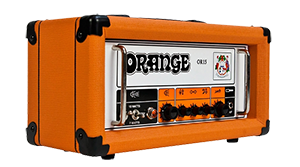 3. Ok man, here’s the verdict on the new Orange now that I’ve had it a few weeks: This is one awesome freakin’ amp! It’s an Orange thru-and-thru right down to the “graphics only” front panel (total 70’s retro). I’ve read that they don’t do cleans all that well, and I guess that’s all in your perception because for me it cleans up fine. Maybe not “Fender” clean, but then again I don’t play that way either. What this little beast does is what an Orange is meant to do: get down and dirty with balls to spare, shake the walls and rattle the windows, and piss off the neighbors. I love it. The FX loop is spot on which makes my Micro-Vibe and Tri-Reverb pedals happy. Dirt pedals aren’t really necessary as the Orange OR15 gets plenty on it’s own, but it will take em on if you want to use them. I kick one on every now and then just to take it over the top. One of the most impressive things is every knob has a noticeable affect at every setting through the entire sweep so the tonal palette is as wide as I’ve ever seen. It’s actually hard to get my brain around just how versatile it is. My style of playing will never need all that it can do, but
3. Ok man, here’s the verdict on the new Orange now that I’ve had it a few weeks: This is one awesome freakin’ amp! It’s an Orange thru-and-thru right down to the “graphics only” front panel (total 70’s retro). I’ve read that they don’t do cleans all that well, and I guess that’s all in your perception because for me it cleans up fine. Maybe not “Fender” clean, but then again I don’t play that way either. What this little beast does is what an Orange is meant to do: get down and dirty with balls to spare, shake the walls and rattle the windows, and piss off the neighbors. I love it. The FX loop is spot on which makes my Micro-Vibe and Tri-Reverb pedals happy. Dirt pedals aren’t really necessary as the Orange OR15 gets plenty on it’s own, but it will take em on if you want to use them. I kick one on every now and then just to take it over the top. One of the most impressive things is every knob has a noticeable affect at every setting through the entire sweep so the tonal palette is as wide as I’ve ever seen. It’s actually hard to get my brain around just how versatile it is. My style of playing will never need all that it can do, but 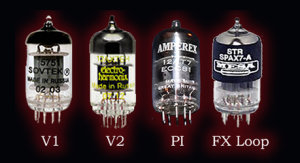 that just means that it will give me more than what I need tonally. The tube array I mentioned in #2 above is still the one for my ears which has NEVER happened on the first go round. Ever. And I run it through 2 1×12 Jet City cabs. Sadly, It doesn’t need any mods either (which I was looking forward to). It’s rich and full with no ice picks up high, no flab down low. On a scale of 1 to 10 I have to give it a 9 because of the ‘no mods’ thing. If I felt the need for 2 channels I would say 8, but I don’t so 9 it is. To wrap this up, in case I was to vague or unclear or you just missed it, I love this thing. Is it for everybody? Nope. But then again what amp is? And my Les Paul has a Gibson 57 Classic + at the bridge and a Jim Wagner DarkBurst at the neck, so that has a lot to do with it as well. The Orange OR15 sounds incredible with my SG single P-90 too. I don’t know, maybe I got lucky and hit the winning combo, but that’s as far as I’m going to analyze it. Now it’s time to go and play! (as always, YMMV)
that just means that it will give me more than what I need tonally. The tube array I mentioned in #2 above is still the one for my ears which has NEVER happened on the first go round. Ever. And I run it through 2 1×12 Jet City cabs. Sadly, It doesn’t need any mods either (which I was looking forward to). It’s rich and full with no ice picks up high, no flab down low. On a scale of 1 to 10 I have to give it a 9 because of the ‘no mods’ thing. If I felt the need for 2 channels I would say 8, but I don’t so 9 it is. To wrap this up, in case I was to vague or unclear or you just missed it, I love this thing. Is it for everybody? Nope. But then again what amp is? And my Les Paul has a Gibson 57 Classic + at the bridge and a Jim Wagner DarkBurst at the neck, so that has a lot to do with it as well. The Orange OR15 sounds incredible with my SG single P-90 too. I don’t know, maybe I got lucky and hit the winning combo, but that’s as far as I’m going to analyze it. Now it’s time to go and play! (as always, YMMV)
See Ya!
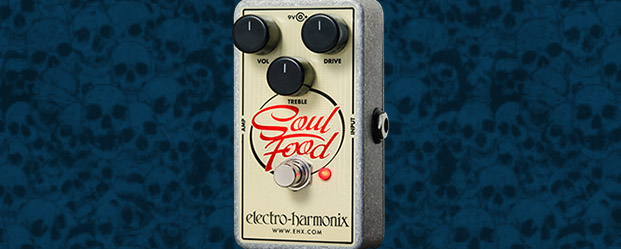
EHX Soul Food Overdrive Pedal
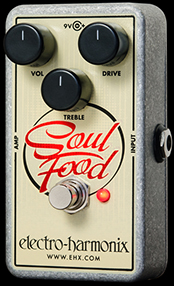 I know what you’re gonna say before you even say it. You’re gonna say “holy crap! this dude bought ANOTHER dirt pedal!” And my reply to that would be “yep I did”. But in my own defense I was talking about one of these for a long time and G.C. finally got some in. So it was “road trip” time again (man, that’s twice in under two weeks. Maybe there is something wrong with me). For $62 plus tax, this is a bargain that’s awfully hard to resist. So I figured why fight it. And it’s a great pedal. They say it’s a Klon clone, and it is pretty close. In fact for the price it’s close enough for me. Typical EHX build quality so it’ll be around a long time, and it’s got an understated but totally cool graphic on it. One thing I want to say up front is that I never really bought into the whole “transparent” claims by a lot of builders. To be fair, maybe those pedals do sound transparent to the builders, but it’s been my experience that every pedal puts some color on the sound. What matters for me is whether or not I like that color. Now I’m forced to rethink that opinion because I believe it actually is transparent. That leads me to believe that I have never tried a truly “transparent” pedal before. It’s produces a really sweet low to medium gain drive, but it also produces a killer boost. The way I understand it is that it steps up the 9 volt power internally to achieve this. And it’s evident when you twist the volume knob. So it runs on 9 volts but only because I guess 18 volts would be redundant (or it would fry the pedal). What ever they did, they did it well. Sounds awesome with my Catalinbread Dirt Little Secret too. I just don’t think you could find a better deal on a new dirt box anywhere.
I know what you’re gonna say before you even say it. You’re gonna say “holy crap! this dude bought ANOTHER dirt pedal!” And my reply to that would be “yep I did”. But in my own defense I was talking about one of these for a long time and G.C. finally got some in. So it was “road trip” time again (man, that’s twice in under two weeks. Maybe there is something wrong with me). For $62 plus tax, this is a bargain that’s awfully hard to resist. So I figured why fight it. And it’s a great pedal. They say it’s a Klon clone, and it is pretty close. In fact for the price it’s close enough for me. Typical EHX build quality so it’ll be around a long time, and it’s got an understated but totally cool graphic on it. One thing I want to say up front is that I never really bought into the whole “transparent” claims by a lot of builders. To be fair, maybe those pedals do sound transparent to the builders, but it’s been my experience that every pedal puts some color on the sound. What matters for me is whether or not I like that color. Now I’m forced to rethink that opinion because I believe it actually is transparent. That leads me to believe that I have never tried a truly “transparent” pedal before. It’s produces a really sweet low to medium gain drive, but it also produces a killer boost. The way I understand it is that it steps up the 9 volt power internally to achieve this. And it’s evident when you twist the volume knob. So it runs on 9 volts but only because I guess 18 volts would be redundant (or it would fry the pedal). What ever they did, they did it well. Sounds awesome with my Catalinbread Dirt Little Secret too. I just don’t think you could find a better deal on a new dirt box anywhere.
Related articles
- Gear Review: ElectroHarmonix Soul Food Overdrive (guitargear.org)
- First Impressions: EHX Soul Food (guitargear.org)
- Waiting to Feed My Soul with the EHX Soul Food! (guitargear.org)
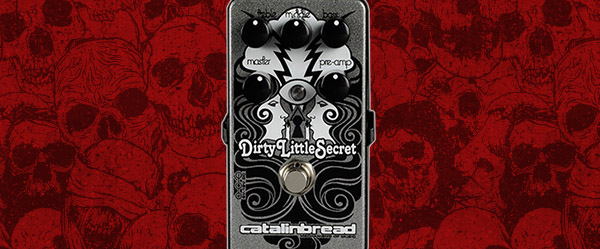
Catalinbread Dirty Little Secret MkIII Overdrive
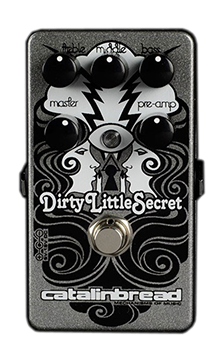 I couldn’t help it. It was one of those days, I was watching demo videos when I hit on one that got the gas (gear acquisition syndrome) goin’ strong! It was Andy at Pro Guitar Shops and a Catalinbread Dirty Little Secret overdrive. I really dig Andy’s demos. You really get a feel for the product because his audio quality is very high and of course his playing is just phenominal. I had seen this video before but I guess I wasn’t listening to the pedal, I was listening to Andy. But this time it hit me like a freight train, that pedal is freakin’ sweet. So after considering at length (about 30 seconds) the possibility of getting one I checked on line to find one locally then hit the road and snagged one ($169 at Sam Ash). This is supposed to be a Marshall in a box, and it certainly is that. It’s got an internal switch to go from Super Lead to Super Bass, and they nailed both. But it’s so much more than that. It has the sweetest smooth overdrive tone of any of my pedals. And it’ll throttle up to full on saturated Marshall with a twist of a couple knobs. Everything about it is so natural sounding. Like how the notes decay without getting frazzy at the end. And it stacks beautifully with other pedals. Catalinbread calls this a ‘foundation” pedal but it kicks ass as a stand alone overdrive. It also has an internal trim pot for presence. I haven’t felt the need to tweak that as of yet but give me time. It will run on 18 volts too, and I will be trying that out in a day or two.
I couldn’t help it. It was one of those days, I was watching demo videos when I hit on one that got the gas (gear acquisition syndrome) goin’ strong! It was Andy at Pro Guitar Shops and a Catalinbread Dirty Little Secret overdrive. I really dig Andy’s demos. You really get a feel for the product because his audio quality is very high and of course his playing is just phenominal. I had seen this video before but I guess I wasn’t listening to the pedal, I was listening to Andy. But this time it hit me like a freight train, that pedal is freakin’ sweet. So after considering at length (about 30 seconds) the possibility of getting one I checked on line to find one locally then hit the road and snagged one ($169 at Sam Ash). This is supposed to be a Marshall in a box, and it certainly is that. It’s got an internal switch to go from Super Lead to Super Bass, and they nailed both. But it’s so much more than that. It has the sweetest smooth overdrive tone of any of my pedals. And it’ll throttle up to full on saturated Marshall with a twist of a couple knobs. Everything about it is so natural sounding. Like how the notes decay without getting frazzy at the end. And it stacks beautifully with other pedals. Catalinbread calls this a ‘foundation” pedal but it kicks ass as a stand alone overdrive. It also has an internal trim pot for presence. I haven’t felt the need to tweak that as of yet but give me time. It will run on 18 volts too, and I will be trying that out in a day or two.
This is now my “always on” drive, and here’s the coolest part: since I got it I haven’t used any other drives with it except the one time just to see how it sounds, because it doesn’t need em. This is my first Catalinbread unit and it’s pretty impressive in every respect (the build quality is second to none). I guess I may have to just grab more of their stuff, so stay tuned.
Related articles
- Catalinbread Effects showcase their new Topanga spring reverb and Karma Suture fuzz at NAMM 2014 | Instruments, Gear and Software (soundcolourvibration.com)
- Time-based Effects II: Delay (professorobsessor.wordpress.com)
- A Primer on Pedal Makers (and Other Stuff) (professorobsessor.wordpress.com)
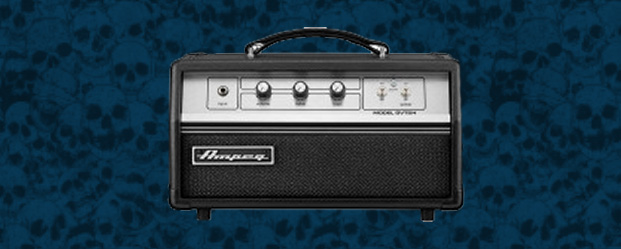
Classic Ampeg tone in a Compact 5 watt package
Ampeg GVT5H 5 watt head
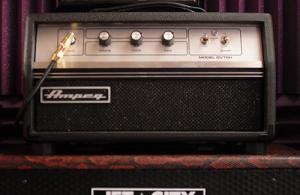 I don’t know if I really needed it, but I finally talked myself into pulling the trigger on an Ampeg GVT series tube amp. I wasn’t looking to replace my Jet City JCA20H, that will never happen. I just wanted a really low wattage tube amp so I could really push it anytime I want day or night. This turned out to be one of my better decisions. I snagged a GVT5H which is the 5 watt head, and this little thing really cooks. The first thing I noticed was the build quality. Typical Ampeg rock solid construction. Definitely styled after the iconic models of the past (think SVT). For what it’s worth, this amp is made in Korea (not China), and I have no doubt Ampeg is riding shotgun on the build process. “So how does it sound” you ask? It sounds like an Ampeg. One thing that makes Ampeg sound the way they do is the Baxandall EQ. The way the tone and bass work is hard to get your brain around, but I had an SVT many years ago so I knew what to expect. To over simplify it, they work within their respective frequency ranges and don’t overlap. They each work as a boost and cut and you utilize their settings to push the midrange. And the tone is without a doubt classic Ampeg. Gobs of clean head room through almost the entire volume sweep. You’ll get a little breakup starting around 7 but it still remains cleanish even at full throttle. But that’s what sets this amp apart from the long list of low watt tube amps on the market now. It really comes into its own as a pedal platform. It loves pedals. I dropped my MXR M77 Overdrive in front of it and it was instant 70’s Stones grind. Same with my Sparkle Drive. Either pedal is a great match for this amp but the one that really takes it over the top and makes you say “Holy Shit” is my EQD Crimson Drive. Volume wise it gets loud. Really loud. And it will take a lot of speaker setups. You can run the following.
I don’t know if I really needed it, but I finally talked myself into pulling the trigger on an Ampeg GVT series tube amp. I wasn’t looking to replace my Jet City JCA20H, that will never happen. I just wanted a really low wattage tube amp so I could really push it anytime I want day or night. This turned out to be one of my better decisions. I snagged a GVT5H which is the 5 watt head, and this little thing really cooks. The first thing I noticed was the build quality. Typical Ampeg rock solid construction. Definitely styled after the iconic models of the past (think SVT). For what it’s worth, this amp is made in Korea (not China), and I have no doubt Ampeg is riding shotgun on the build process. “So how does it sound” you ask? It sounds like an Ampeg. One thing that makes Ampeg sound the way they do is the Baxandall EQ. The way the tone and bass work is hard to get your brain around, but I had an SVT many years ago so I knew what to expect. To over simplify it, they work within their respective frequency ranges and don’t overlap. They each work as a boost and cut and you utilize their settings to push the midrange. And the tone is without a doubt classic Ampeg. Gobs of clean head room through almost the entire volume sweep. You’ll get a little breakup starting around 7 but it still remains cleanish even at full throttle. But that’s what sets this amp apart from the long list of low watt tube amps on the market now. It really comes into its own as a pedal platform. It loves pedals. I dropped my MXR M77 Overdrive in front of it and it was instant 70’s Stones grind. Same with my Sparkle Drive. Either pedal is a great match for this amp but the one that really takes it over the top and makes you say “Holy Shit” is my EQD Crimson Drive. Volume wise it gets loud. Really loud. And it will take a lot of speaker setups. You can run the following.
1 x 4 Ω cab
1 x 8Ω cab
1 x 16Ω cab
2 x 8Ω cabs
2 x 16Ω cabs
I was running it through a 2×12 closed back 16Ω cab loaded with a pair of vintage Eminence speakers, but then something magical happened: I came up on a brand new 16Ω WGS 12″ British Lead 80 that I installed in a Jet City 1×12 closed back cab. I fired it up and “holy crap” it sounds freakin’ amazing! So that’s how I’ll run it. I can’t even imagine it sounding better.
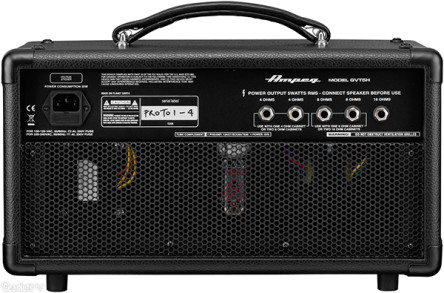
I got it used and it came with a Ruby 12AX7 preamp tube and a 6V6GTEH output tube installed but the dude also threw in 2 GE 6V6GT black plates. First thing I did was to replace the Ruby with my favorite preamp tube, a MESA SPAX7-A, then I tried both output tubes and they all sound good with the GE’s being a little smoother than the EH’s. If I was to rate this amp on a 5 scale it would get a solid 5 IMHO. If I could add one thing to it I would go for a second gain stage (or even a master volume) just so I could drive it without using a pedal at all. And if I ever run across a diy modder that knows this model and can give me some direction then it just may get that extra gain stage. But if not I’m still more than happy with it. And if there are any modders willing to take a look I have the schematic.
What I find really sad is that it appears Ampeg has discontinued the GVT series as of Jan 2014 (they still show them on the website but the link for “find a dealer” as well as the “buy now” link produce “0” results). Seems every so often they try another run at the guitar amp market but just can’t get close to the success they’ve had with their bass amps. Could be because they didn’t promote them very aggressively. Bottom line is if you get the chance (and a low wattage ass-kickin amp is on your radar) grab one while you can.
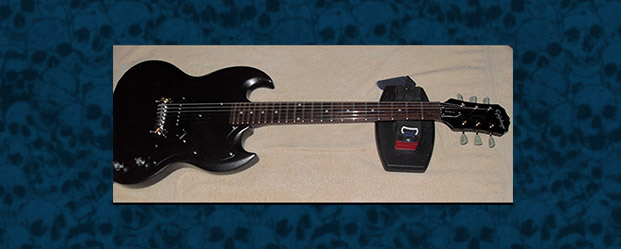
Rebuilding Epiphone SG Jr
Out of the blue I decided I just had to have a p-90 equipped axe, but I didn’t want to spend a lot of money. So I hit the trail and located a 97′ model Epiphone SG Jr. It was a little rough but it was intact, and the price was right ($85.oo) I bought it Friday night and rebuilt it on Sat and Sun and was playing it Sun night. See image at the bottom of post for a list of what went into it. Oh yeah, I almost forgot, it actually plays great and it’s got tone for days!
(sorry about the crappy pics, my digital camera has started acting weird. As soon as I get a replacement I’ll put up some sharper images)

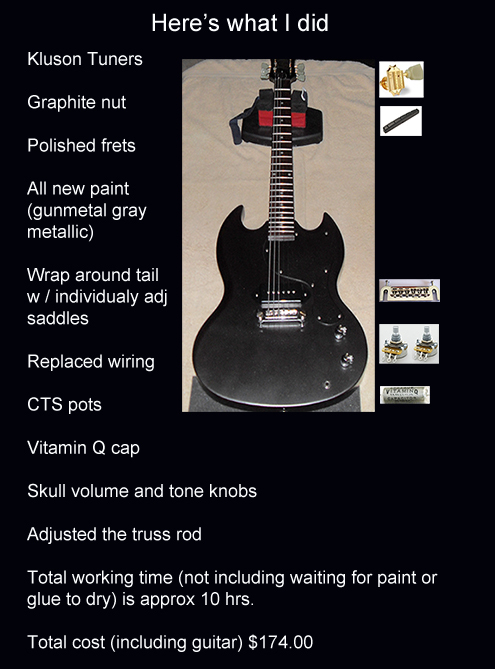
Related articles
- Sir Paul McCartney interview: ‘I’m telling my entire life story here’ (991.typepad.com)
- Revelator – Gillian Welch (solos by David Rawlings) (songsfromsodeep.wordpress.com)
